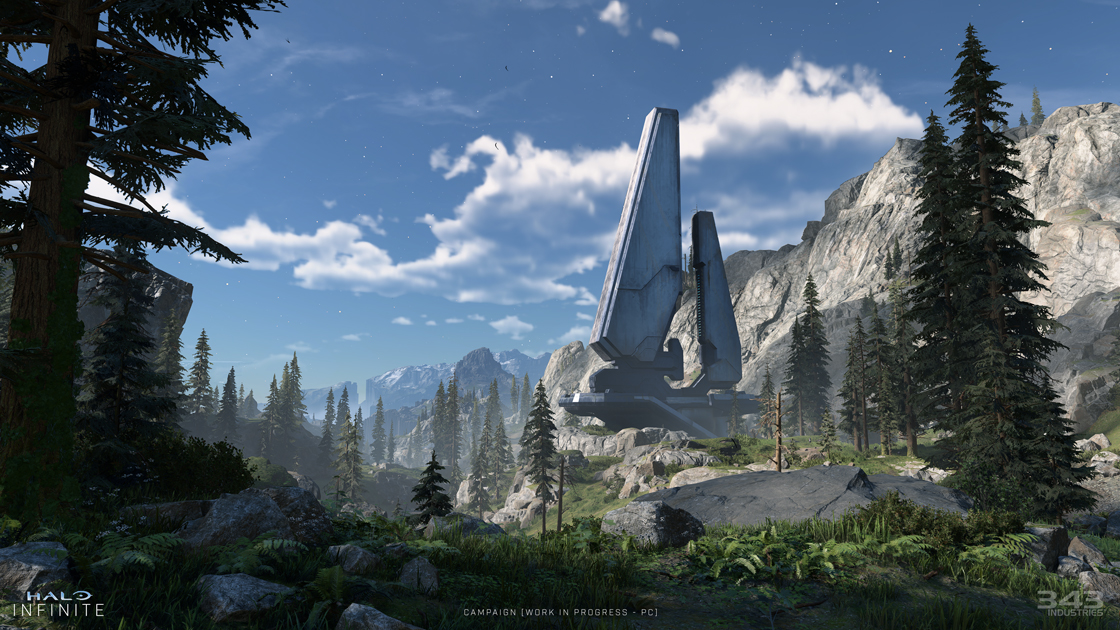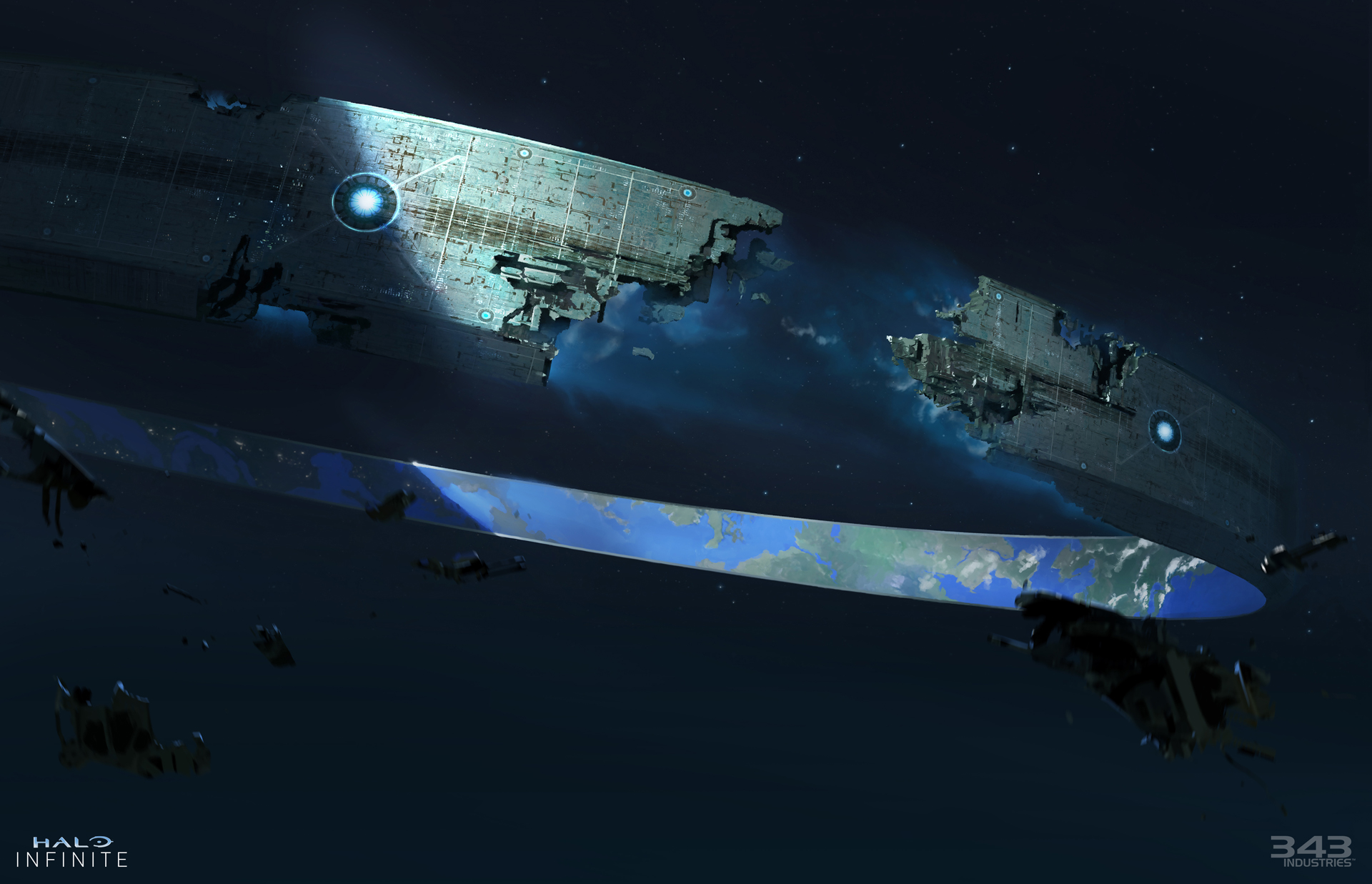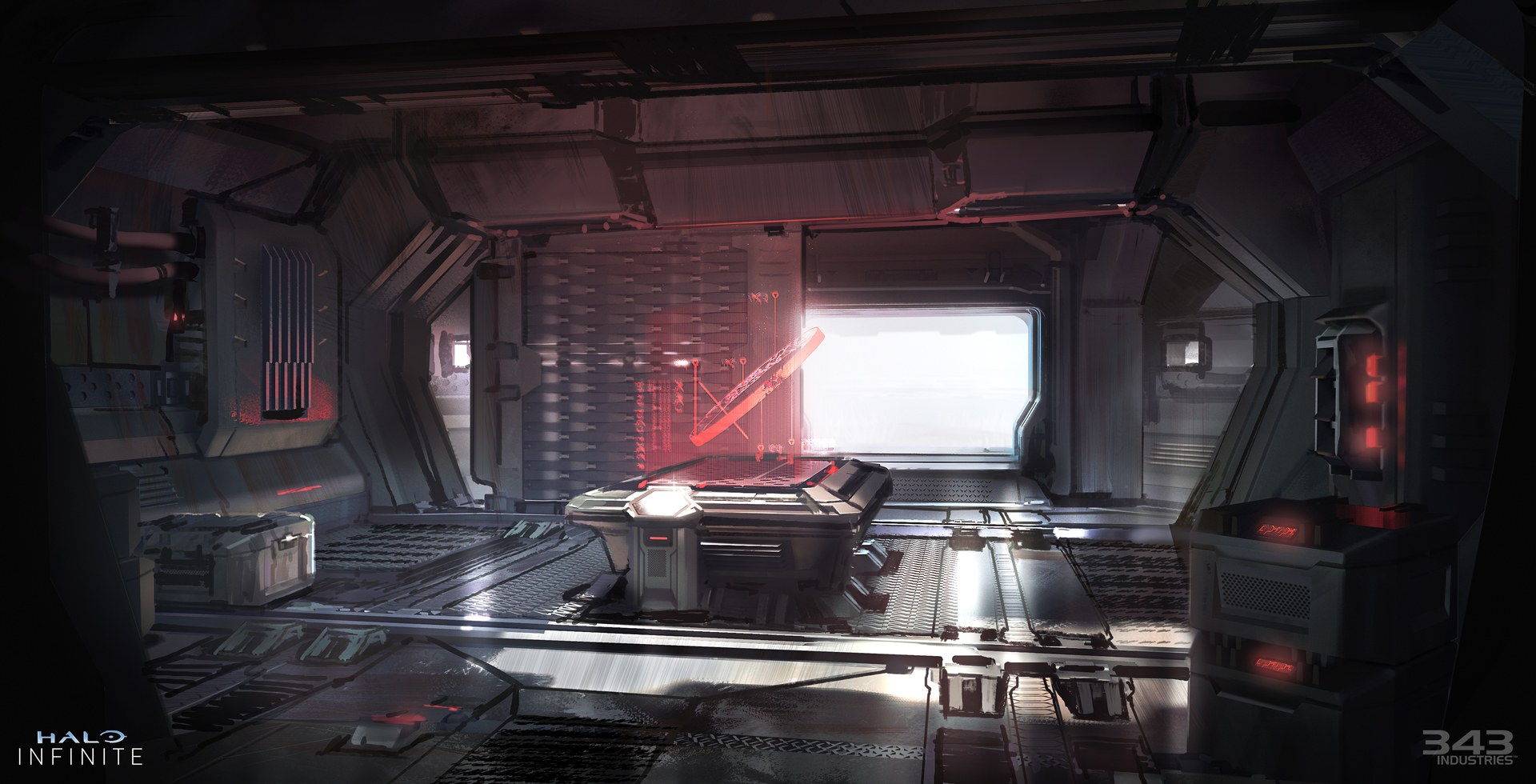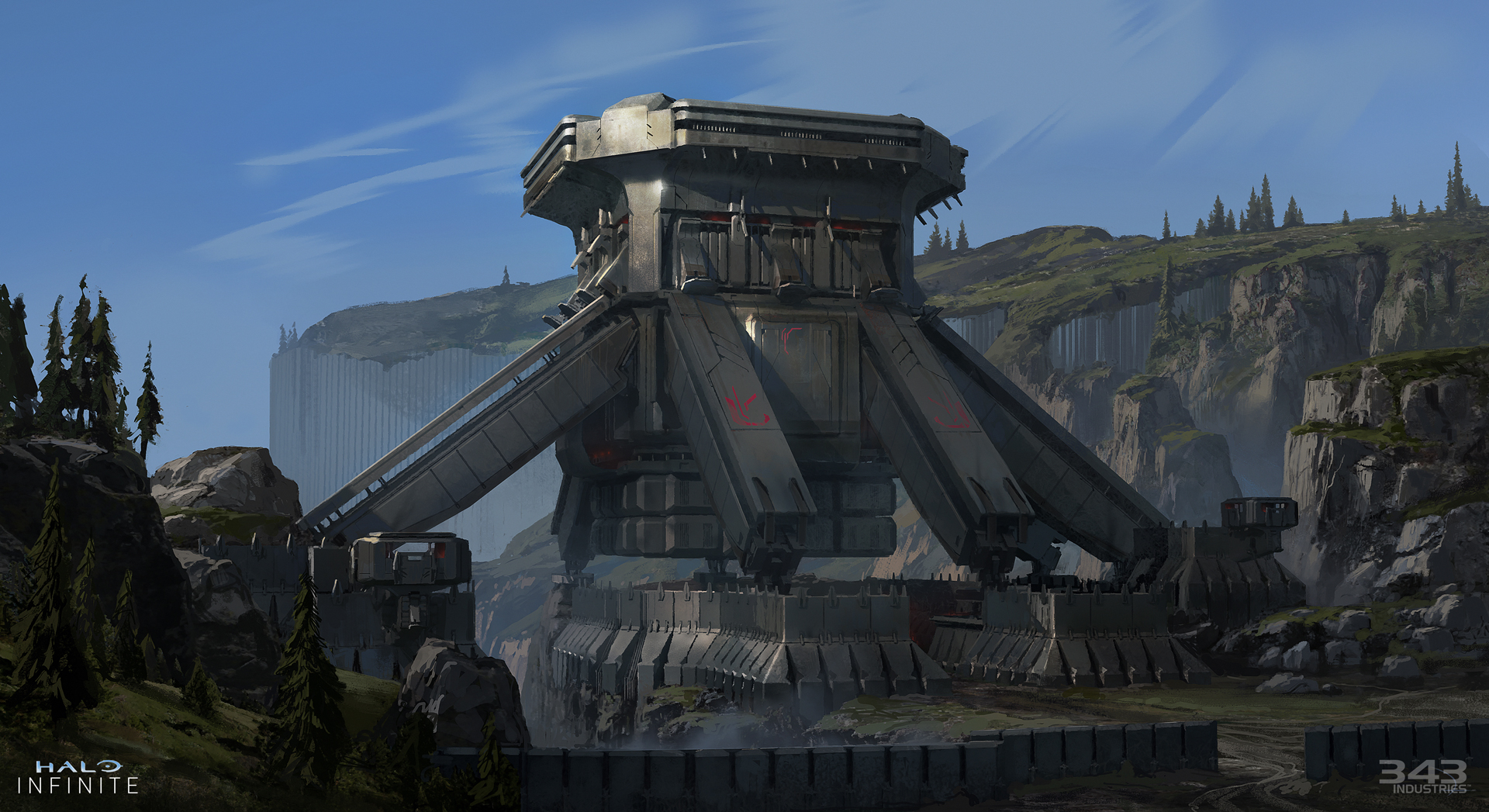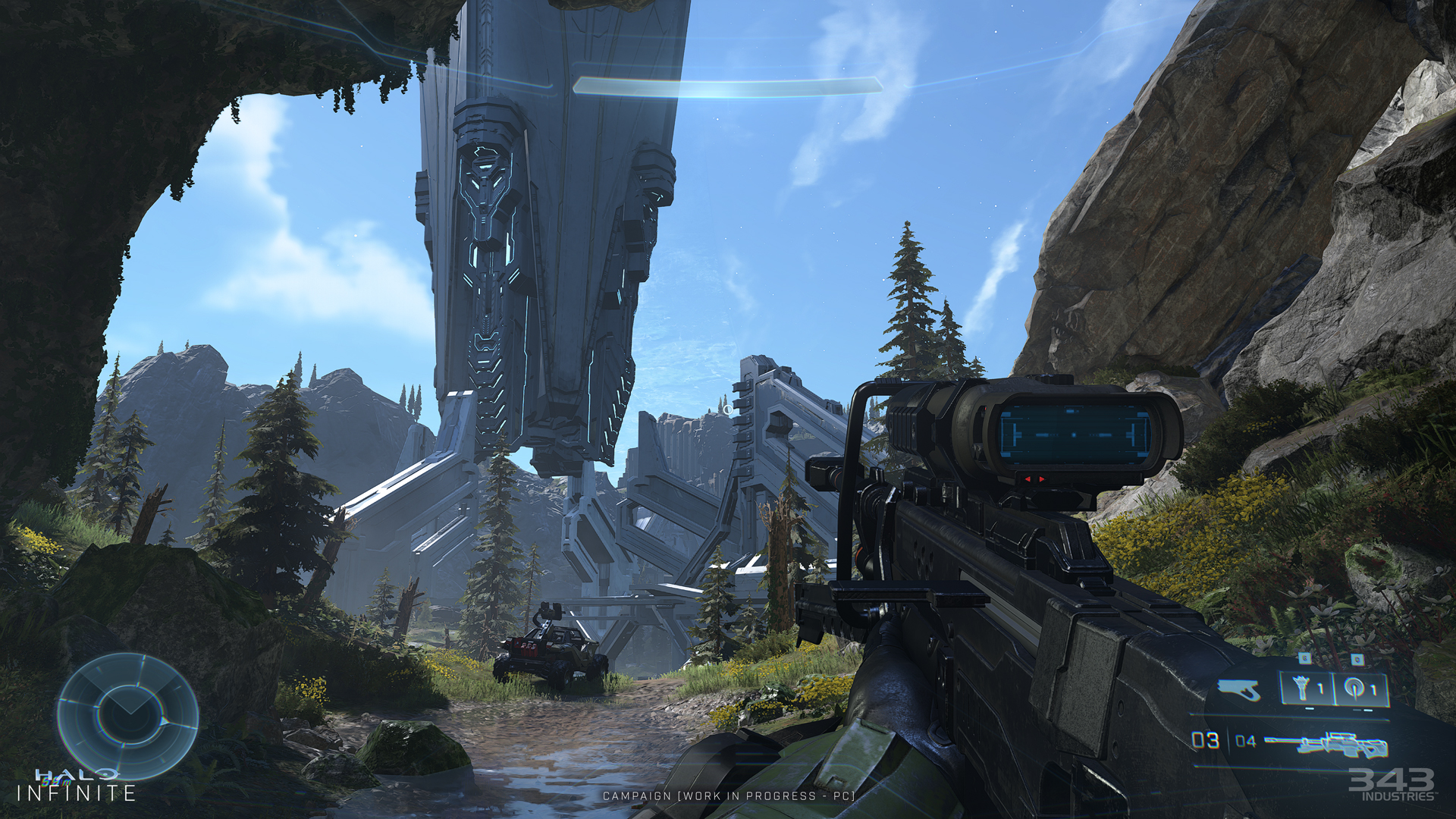Products You May Like
Bringing Zeta Halo to life
As is customary for these blogs, let’s get started with a quick round of introductions – who are you, what does your job entail, and what’s your history with Halo?
Justin Dinges – Hello, my name is Justin Dinges and I am the Campaign Art Lead on Halo Infinite. I’ve been with 343 Industries for the past 10 years and during that time I’ve had the pleasure of working as a Multiplayer Map Lead on Halo 4 and the Campaign Lead Environment Artist on Halo 5. My current role as Campaign Art Lead has me overseeing and managing the artistic world construction of our massive campaign experience. At a high level, my job is to merge our incredible Art Direction, established by our Art Directors, with the overarching design and creative goals established by our Design and Creative Directors to ensure that we make the best experiences for the player. Building worlds within the Halo universe has been an amazing experience thus far and I am extremely excited with where we can continue to take our ever-evolving ambition that is Halo Infinite.
Troy Mashburn – I’m Troy Mashburn and I began my 343 career as the Sandbox Lead in 2017. I was responsible for setting the direction of the sandbox and introducing new gameplay features to Infinite. In 2019 my role and responsibility changed to Gameplay Director responsible for gameplay across the campaign experience.
John Mulkey – Hi everyone. My name is John Mulkey and I joined 343i in 2018. I am the World Design Lead on Halo Infinite where I have the pleasure of leading the Design Team that gets to take all the hard work of our partner teams in Sandbox, Character, Narrative, and Art and weave them together to form the various missions and adventures Chief experiences across Zeta Halo.
So far, our Live and Sandbox Teams have shared insights into their vision and goals for their respective team’s aspects of Halo Infinite. When you and your teams set out to accomplish their tasks each day, are there any guiding principles?
JD – As far as our artistic goals for the campaign goes, we have focused on two key themes, “Legacy” and “Simplicity”, when it comes to the visual experience we are building. For “Legacy” we really want players to feel like they are experiencing a game that they remember fondly (Halo: Combat Evolved), but with modernized graphics of course. As far as “Simplicity” is concerned, we wanted to ensure that we steer away from overly noisy designs and details which is a key takeaway for the team coming off Halo 5. With Halo Infinite, we wanted to take this new adventure back to its roots and create a visually pleasing experience that doesn’t overwhelm with unnecessary complexity where readability and clear artistic composition prevail. This is our artistic interpretation of a beautiful world to exist within – rather than something that is purely grounded in photo realism. Both goals have been a true challenge to balance, especially against the expectations of what it means to be a “next-gen” title, but through some incredible team collaboration, hard work, and community feedback we are hoping to land something that everyone will really enjoy and appreciate.
TM – The campaign experience is the result of many teams coming together to tell the Master Chief’s story. At a project-wide level, we use terms like “Super Soldier”, “Story Driven”, and “Spiritual Reboot” to help describe the experiences we want to deliver. These are used like filters to determine if a particular feature belongs in the game. Things like “Super Soldier” sound like a no-brainer but it’s used frequently to call out when something isn’t supporting the super soldier goal. “Story Driven” also sounds obvious but it’s a great reminder that we are here to tell Chief’s story. And “Spiritual Reboot” …well more on that below.
JM – As Troy stated, we have guideposts we use to ensure the game lives up to being a Halo experience at heart. Beyond that, my team has a number of best practices we use to ensure the design of the spaces and experiences offers opportunities for various play styles and leverages the sandbox in cool ways. For instance, it is not enough that there are roads connecting various points of interest, we want to make sure there are opportunities for “Sick JumpsTM” the player can hit when racing along on a Mongoose with a Marine on the back. We make sure there are opportunities that allow certain weapon choices to shine, opportunities for really satisfying use of equipment options, and opportunities for a well-placed Plasma Coil to really put a smile across your face.
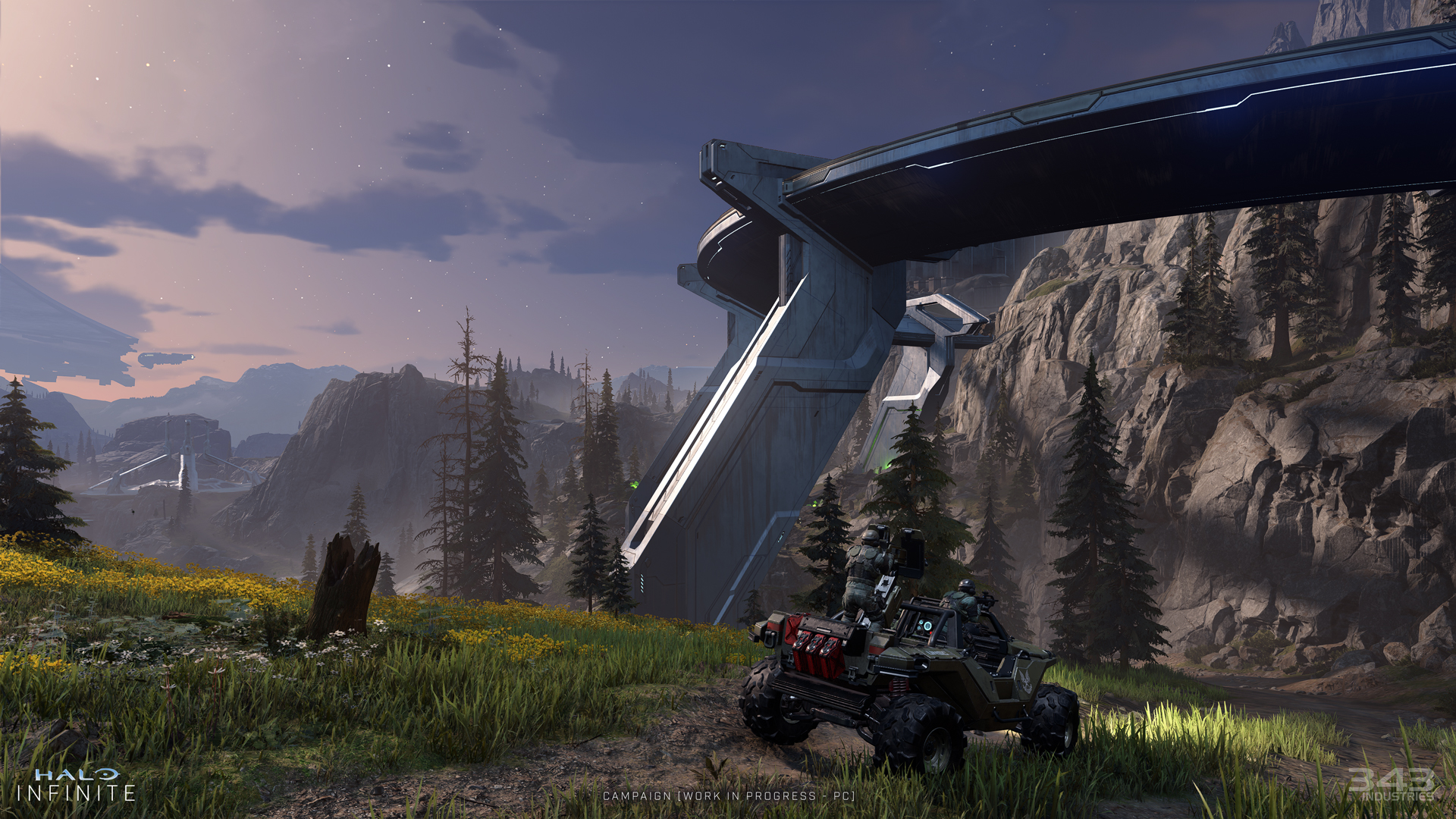 Rescue Marines, jump in a Warthog, and discover everything Zeta Halo has to offer.
Rescue Marines, jump in a Warthog, and discover everything Zeta Halo has to offer.
Where do you look for inspiration when it comes to bringing this world and these experiences to life? Are there specific element(s) of prior Halo game(s) that you looked to?
JD – Our main source of artistic inspiration for Halo Infinite’s setting began right in our own Pacific Northwest backyard. Because we made that early decision to go back to Halo’s roots and recapture the PNW art pallet on Zeta we immediately headed out into the mountains, forests, and valleys for not only personal inspiration but more importantly lots of photo reference. As humans we can imagine what we think a natural biome should look like, we will make lots of guesses, but until you can experience it for yourself you will most likely never be able to fully realize it.
Armed with these references and experiences we then leaned on our amazing Concept Art team, led by our incredible Art Directors, to merge the real-world relatable photos and anecdotes with what it means to be a science fiction world. So as an example, you can see in many of our media pieces we have introduced the idea that just below Zeta Ring’s organic surface is a forerunner framework of millions of vertical hexagons that make up the ring’s structure. And, due to the extreme damage that Zeta has endured, these hexes are exposed and displaced creating a dynamic landscape that gives us a unique visual and allows for some really fun gameplay. This is our way of mixing a beautiful real-life biome (the PNW) with something fantastic and sci-fi (the hexagonal structure) as the experience aims to be the best of both worlds.
You can also see this same form of inspiration and process applied to the planet Sanghelios in Halo 5 – where in that case we had traveled into the slot canyons of Zion National Park in Utah and gathered both inspiration and photos for the world we hoped to envision. It is a really great method for building new and relatable worlds in the Halo universe.
TM – Designing games for me is about crafting amazing experiences that pull you so far into the game you think about it even when you are not playing. It’s no surprise that “The Silent Cartographer” from Halo: CE is one mission that stands out clearly in my memory.
This mission starts with Halo theme music playing as you fly low over the ocean to an island, where you are seamlessly dropped off to clear the beach with a squad of Marines, but wait it gets better! Foe Hammer drops off a Warthog, next thing I know I am driving around with a gunner in the back taking out enemies as I drive around the island.
This mission made me feel like I was in control, initiating combat when I chose, on foot, or in a vehicle, interior, exterior, with Marines and without. Recapturing the feeling of this mission has been one of the inspirations behind my gameplay direction.
Banished installations, as shown in this concept painting, offer a stark contrast to the lush PNW-inspired exteriors of Zeta Halo.
We’ve talked a fair amount about Halo Infinite being a “Spiritual Reboot” – what does that mean to you from your specific perspectives?
JD – From an artistic standpoint it means that we want to both introduce new players and welcome back old players with the iconic Halo imagery the original games were built on. We want players to have that sense of awe and wonder as they step into the world we are building – this goes back to our goals of “Legacy” and “Simplicity” that we constantly use as our lenses to make artistic decisions. As a prime example, we have specifically chosen to begin Chief’s journey in Halo Infinite within the Pacific Northwest forest biome on a new Halo ring, a deliberate ode to the past. Another good example is how we have taken the visual design of the Jackals and Grunts back closer to their appearance in Halo 3 and previous titles. We want players to feel a nostalgic familiarity with these designs, like meeting up with an old friend, as they experience all that Halo Infinite has to offer.
TM – “Spiritual Reboot” is a term we use to describe our approach to introducing new ideas while staying true to what it felt like to play the classic games. “Feeling” is the key word here because we want to evolve, by creating new experiences and new opportunities, but still maintain the original essence.
The Grappleshot is a great example of adding something new that also super-charges things you are already familiar with like clamber or melee. You are familiar with clambering up a double stack of crates but the obstacles in Infinite are larger and more organic. The Grappleshot gives you the same fluid motion as clamber with a much greater range to get to more locations quickly.
Also – if you are a fan of using melee, like I am, you are going to love grappling towards enemies to land that powerful knockout blow. Sooo satisfying.
JM – When I was looking at possibly joining the 343 team to work on Halo Infinite it was the “Spiritual Reboot” concept that had me incredibly excited and made it absolutely mandatory that I join the team to work on this project. 🙂
For Infinite we are working to deliver on the ‘promise’ of the original in ways that limitations of the time would not allow the team to fully explore. Zeta Halo invites exploration and discovery, the stories to be found, and player agency in how you utilize a robust sandbox of tools to overcome a mission or encounter.
Can you talk some about the process and collaboration that goes into creating Zeta Halo and its experiences? Does the world team create a cool space and then the gameplay designers jump in to layer on the fun? Or do the designers spec out the experiences as a blueprint for the world team to go off and build?
JD – This can be a complex one to answer easily as it really depends on the specific experience being built. The world we have created for Halo Infinite is very large and with a finite team size to create it all we must be strategic in how we build each experience – there’s no one size fits all method for this project. So, in some cases it makes sense for design to go first and layout a space that’s fun for combat with an artist following to ensure visual qualities are being met. In other cases, it might mostly be an artistic endeavor that has a world artist creating the space with a designer following afterwards to place any gameplay aspects on top. And sometimes it’s a very tight collaboration between a designer and artist to make the best experience possible. At the end of the day each experience we create is a collaboration between many disciplines trying to make the best game that we can.
TM – I wish I could describe the perfect game development formula here but that just doesn’t exist. Making games is an organic process with many constantly changing variables like technology, deadlines, budgets, people, and pandemics. A typical process starts as a rough art “block mesh” where design iterates until it proves fun to play. There is back and forth between design and art until we decide to lock it down. Unfortunately, due to one reason or another, things rarely go perfectly to plan. These situations may call for a re-design, reduction in scope, or cutting a feature all together. This isn’t necessarily a bad thing, it’s just part of the game making process. In the end great games are made by art and design working together.
JM – I think Troy and Justin have described our experience of creating the game very well. The best results always come from collaboration and as we move forward collaboration will be a core aspect of processes we continue to iterate and hone.
Banished strongholds, as shown in this concept painting, can be approached from nearly any direction with more tactical options than prior Halo games.
What’s your personal favorite aspect of this world and/or the experiences therein?
JD – One of my favorite features in the game is our Time-of-Day lighting system that is active while you are playing the game. This has been one of, if not THE largest graphical feature implemented into our engine over the past few years. It allows us to create artistic scenes and settings that have vastly different visual tones and moods depending on which time during the cycle you encounter something. So, coming across a mysterious Forerunner obelisk during the day may feel peaceful and serene, where at night it might feel much more ominous and threatening – it really adds some incredible dynamically-driven visual variety throughout the experience where we were not able to have it before.
TM – For me games are all about the experiences they create. I want to be challenged, engaged, and surprised. Every time I talk about gameplay you will hear me talk about player opportunity because I feel its key to creating an immersive experience. It’s difficult to pin down one favorite aspect of the world because it is really the sum of its parts. The world of Infinite presents you with challenges and a box full of toys. How you overcome those challenges is up to you.
JM – I love the agency we are creating that really doubles down on that premise of delivering on the promise of Halo: CE. Enemy strongholds can be approached from any direction and there are so many options available for how you take on the challenges at hand. Do I blaze through the front gate in a Warthog full of Marines and just light the place up with zero subtlety? Do I scout the perimeter and discover a subterranean entrance that allows me to enter through one of the interior structures? Do I Grappleshot to a sniper tower, take out the inhabitant and begin picking off enemies from my raised vantage point?…there are so many options available that allows everyone to approach the game the way they want and have their own unique experiences. I am excited to hear stories of all the different ways players have taken on missions in the game once we are released.
Halo Infinite’s time-of-day lighting system dynamically changes the mood and atmosphere on Zeta Halo.
Story is going to be coming at the player from every angle and it’s safe to say Zeta Halo is as much a ‘character’ in Halo Infinite as Chief, the Pilot, or Escharum. How does the world, and the World Team’s work, support the narrative experience?
JD – This is a great point, Zeta Halo is very much a character in and of itself. The landscape, the mysterious structures, the surrounding vistas and even the wildlife found on it act as unique characteristics of the ring – we want Zeta to feel like a real and living place regardless of whether the player is present or not.
Most importantly there’s an epic visual story to be told of not only what recently happened to it but also one that implies its mysterious past and what implications it holds for the future. So, from an artist’s perspective, we have had two main goals with bringing Zeta to life: First, to visually show what is happening in current times with the violent occupation of the Banished forces and how it has shaped the landscape of the ring. And second, to create mystery and intrigue around Zeta’s past and ultimate purpose. Intertwining these two major story characteristics of Zeta has been an awesome and rewarding challenge. Players will not only experience the immediate story of Chief’s reawakening to confront the Banished and Cortana but if they look around, they may find glimpses of the future as well.
TM – The Ring definitely has its own story to tell, and the environment artists have done an amazing job bringing this to life. Memories of past battles scars the surface, and evidence of bigger events can be seen in the fractured chunks of the Ring floating in the sky. This is something I really care about because I am more of a “show me don’t tell me” kind of player. I find that discovering things and figuring things out for myself go much further to immerse me in this world.
JM – There are missions that will pull you through the “Golden Path” of the primary narrative, but more than any previous game, we are breaking down the walls to create a more open play space offering exploration and discovery. What is that odd tower in the distance, I see a smoke signal over that ridge, what is the source of the odd hum? Go find out. There are entire stories to be discovered. I often describe the experience offered by Zeta Halo as “Halo unleashed” because it is all the experiences and stories you love from Halo presented in a world where you have so much more freedom to explore and discover unexpected adventures.
How does the introduction of new Equipment and traversal mechanics like the Grappleshot factor into the creation of this environment? And, how does it inform the foundation for encounters within the world?
JD – Having a tool like the Grappleshot definitely challenged us to rethink the way we build our environments because it’s such a versatile and fun mechanic that allows players to get nearly anywhere that they can reach. The art team has had the added challenge of ensuring that we do allow for players to get to spots and areas that in previous titles we may have prevented them from getting to. The good news is that not only is the gameplay that much more fun because of it, but we can also expect players to get to some really awesome locations and vantage points that will further show off the beauty of the world we have created. For me, the Grappleshot is an exciting example of a new gameplay feature that provides great wins for both players and devs alike.
TM – One of our core goals is to provide players with more sandbox opportunities so they can be creative in their approach to problem solving. Equipment like the Grappleshot is a great example creating new and exciting possibilities. Walls, cliffs, and small gaps don’t stop Chief any longer which gave us the opportunity to rethink how encounters are built.
This caused some challenges early on because designers couldn’t just place the final objective at the far end of a base assuming players will have to fight their way through. With the Grappleshot, players can go wherever they want whenever they want. From a development standpoint, this was both terrifying and completely liberating at the same time.
As a player, I like to figure out the best way to approach a situation and my “best way” might be different than yours. The Grappleshot helped the team break out of the single path design mindset and evolve into something much more exciting. It’s become so second nature that when I play other games, I find that I miss the grapple.
JM – The Grappleshot is super fun in the traversal options it provides, but it also allows for pulling weapons to you, pulling an explosive Fusion Coil to you that you can then throw to take out a Shade Turret, or grapple to…and launch yourself into an enemy to land a powerful melee attack. Beyond the undeniable fun of the Grappleshot, you can carry around another three pieces of equipment with their own unique roles and utility that you can quickly swap between at any time. The combinatoric play you can create in this way opens an astounding number of play options and I cannot wait to see the YouTube videos people share showing off moves we never even imagined when developing them.
Explore the mysteries of Zeta Halo the way you want, taking full advantage of an expanded sandbox featuring familiar weapons alongside brand new additions.
What impact does co-op have on the gameplay experiences across Zeta Halo?
TM – Campaign is about telling the next great chapter of the Master Chief’s story and the co-op experience is about playing this story together with your friends. The solo gameplay experience is designed to provide players with options on how they want to tackle situations. These options translate well into co-op by allowing for different playstyles. The great thing about being a sandbox game, it means there is no right way to use a particular item or feature. I can’t wait to see co-op players doing crazy stuff and combos we didn’t even think of.
JM – As mentioned above, Halo Infinite will be offering some of the most open-ended play experiences in the history of Halo with an enormous sandbox of ingredients to bring to bear. So, when you add the idea that we can play together to that matrix of player choice driven experiences, the possibilities just explode.
As we look ahead to launch this Fall, can you give us a sense of what you and your team are focused on over the remaining months?
JD - For sure – the Art Team, like most of the development teams, are quickly wrapping up all of our remaining tasks and polish items as we approach our bug-fix and performance stage of the game’s production. We will be spending the final months fixing bugs ranging from floating trees to T-posing enemies, as well as ensuring that the game runs smoothly across all the platforms. While not the most glamorous phase of development, it is the most technical and crucial to shipping.
TM – The team is 100% focused on wrapping up the campaign experience which includes gathering and addressing user feedback (both internal playtests and User Research data), bug fixing, performance, and balancing.
Thank you all for taking the time to share your insights and work with our community today! Before we go, any parting comments you’d like to pass along?
JD – A pleasure for sure! I just want to say thank you to everyone in the community who so passionately follow our progress and hunger for more – we try our best to listen to your feedback and make the best decisions for you all and the franchise. Making games is immensely rewarding but also exceedingly difficult, every decision has a silly amount of complexities that need to be considered – let alone doing it while working from home amid a global pandemic. This release will be a building block from which we can continue to grow our Halo storytelling and experiences quicker and more polished than in the past. Just know that we are working as hard as we can to deliver the best experience possible, and we truly hope you all love it. Looking forward to showing more in the near future!
TM – Thanks for asking the questions. I love having the opportunity to reach out to the community and share insights into what we do. It takes a lot of blood, sweat, and tears to make something this ambitious but the players are what makes it all worthwhile. It’s a privilege to work on such a beloved franchise that I have been a fan of ever since Chief first stepped out from the cryo pod in Halo: Combat Evolved. I look forward to sharing more developer stories and gameplay as we head towards release.
JM – Any chance to talk about this game is an absolute pleasure. I cannot wait to hear the experiences players create once they get their hands on Infinite.
Thank you all so much for your hard work thus far, and we really appreciate you taking the time to answer our questions about Zeta Halo.
Now, let’s hear from a few more 343ers about the great work they’ve been doing across the board. It’s story time with Tales from the Trenches!
